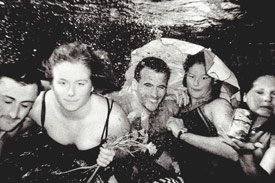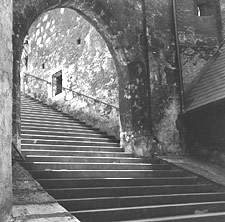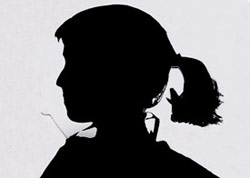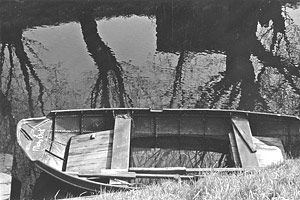Colby-Sawyer College Hosts Exhibition of Women's Photography

NEW LONDON, N.H. - A new exhibition at Colby-Sawyer College in February will explore the perspectives of four women—Linda Ost, Margaret Cawley, Pamela Pecchio and Adrienne Campbell— in an exhibition of their black-and-white photography. The show features a broad range of subject matter and artistic processes, from photograms of people and nature to mixed media installations and travel photography.
“Women in Photography” begins with an opening reception and performance on Friday, Feb. 1, from 5 to 7 p.m. at the Marian Graves Mugar Art Gallery at Sawyer Fine Arts Center. The exhibition, sponsored by Colby-Sawyer's Fine and Performing Arts Department, continues through Feb. 26. Admission is free and open to the public.
The exhibition brings together four artists at different stages in their careers and lives in an exploration of diverse themes and approaches to their work, according to Rebekah Tolley, director of the art gallery and assistant professor of Fine and Performing Arts.
“We are currently undergoing a dramatic change in photography from the analog to digital world, and this exhibition features some artists dealing with the transition in their work and their teaching, and others whose training is based in an analog tradition that is fast becoming financially inaccessible to artists,” says Tolley. “This exhibition reflects on the shift from analog to digital and what both can offer and celebrates the dramatic point of change that's occurring for many photographers and photography programs across the country.”

Margaret Cawley, an alumna and former faculty member of Colby Junior College and resident of Concord, N.H., studied music at New York University and the University of Michigan. At age 14, she began viewing the world though a camera lens, which propelled her into her “other life.” With no formal training in photography, Cawley instead studied the great works of Ansel Adams, Alfred Stieglitz, Paul Strand and others, as well as the abstract paintings of Piet Mondrian. For eight decades now, she has sought to “to make a picture that wasn't there before,” as Austrian painter Oskar Kokoschka's once described the role of artists.
“Using only black and white and intermediate grays, I feel no need for other colors,” Cawley says. “With my medium format Hasselblad 2 ½-inch camera, light and shadow, reflections, texture and contrasts are all that is needed to make significant forms.”
In addition to photography and music, Cawley is also involved in letterpress printing with her own Fiddlehead Wood Press. Examples of her printing work will also be included in the show. In explaining why someone who devoted most of her professional life to teaching music would also commit so much of her time to photography and letterpress printing, Cawley says “It is all in the pursuit of beauty…beauty of lines of music, lines in a photo image or lines of handset type.”
Linda Ost, a visiting professor at Colby-Sawyer since 2005 and resident of Newbury, N.H., earned an M.F.A. from the Savannah College of Art and Design. In her current work, she focuses on different kinds of connections--the act of bringing things into contact, a link between communicating computers, a relationship between members of a structural model or a channel of communication.
“When you look at the inner workings of electrical things, often you see small and big wires, new and old, cheap and expensive, lined up and intertwined,” Ost says. “Until the current passes through them, there will be no connection. Maybe just looking and listening and connecting are the real purpose, the genuine objective of being live and alive. But, even when wires sometimes don't connect properly, they leave a current, a residual energy, long after the contact.”

Pamela Pecchio, assistant professor of photography at the University of North Carolina at Asheville, earned a B.F.A. and M.F.A. in photography from the University of Georgia at Athens and Yale University, respectively. Much of her work explores human relationships to the natural world, with images inspired by the landscapes of the southern United States. These images are photographed from inside the spaces people inhabit, which separate them from nature and act as both barrier and passageway.
“I see in myself, and others, a disconnection from the land, and need for reconnection. I am interested in the tension that exists in the space between things and the line where opposing forces meet,” Pecchio says. “We often experience the landscape in this way, as we view the day outside without being in it. These images draw upon a realization that an innate, instinctual relationship has changed slowly and unknowingly.”
In recent years, Pecchio has begun to explore the roots of photography and her own relationship to it through silhouettes. She had entered the field with portraitures and recently returned to making images of her family, this time by making simple photogram profiles of each person. She creates cameraless images by laying each profile on light sensitive paper and exposing it to light, and then printing the photogram negative as a positive in a digital darkroom.
“The popularity of the silhouette, once a form of affordable portraiture, was radically affected by photography's birth in the mid-19th century,” she explains. “I wanted to reference this relationship and also the current movement into digital photography.”

After graduating from Cooper Union Art School Adrienne Campbell of Elkins, N.H., studied photography with Berenice Abott and Harold Feinstein. Early in her career she worked as a photography researcher and book designer at Harcourt Brace, McGraw-Hill, and Ginn and Company. She later taught photography at New England College and Colby-Sawyer College.
Campbell's photographs reflect her extensive international travel and varied interests. Her images focus on children, animals, and her travels, along with photograms of fruit and vegetables. Her photography is in numerous private collections and a public collection owned by the state of New Hampshire.
The Women in Photography exhibition will also present some of the artists' color photography and a small selection of their other works.
The Marian Graves Mugar Art Gallery, directed by Rebekah Tolley, hosts seven major exhibitions and related public events each academic year. The gallery is located on Seamans Road on the west side of campus in the Sawyer Fine Arts Center. Admission is free and events are open to the public. Gallery hours are 9 a.m.–5 p.m., Monday through Friday, Saturday from 10 to 2 p.m., and other times by appointment. The Mugar Gallery and Sawyer Fine Arts Center are fully handicapped accessible. For information, please call (603) 526-3000.
Colby-Sawyer College, 541 Main St., New London 03257


